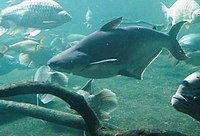
Photo from wikipedia
Global hydropower development is one solution proposed to address the increase in energy needs. However, hydropower-related impacts on riverine ecological systems are not well understood. The Mekong River Basin (MRB)… Click to show full abstract
Global hydropower development is one solution proposed to address the increase in energy needs. However, hydropower-related impacts on riverine ecological systems are not well understood. The Mekong River Basin (MRB) is one of the world’s largest waterways and is presently experiencing significant hydropower expansion. It is also one of the most biodiverse rivers; serving as home to many species that are blocked or hindered by the development of dams. One source of injury and mortality for downstream moving fishes is passage through the turbine environment where fishes may be exposed to several physical stressors (e.g. shear forces, rapid decompression, blade strike and turbulence). The current study sought to understand the susceptibility of blue gourami (Trichopodus trichopterus) and iridescent shark (Pangasianodon hypophthalmus) to shear forces. Fishes were exposed to an underwater jet with velocities up to 21.3ms–1 (equating to strain rates of up to 1185s–1) and were assessed for behavioural effects, injuries and mortality. Overall, it was determined that both species were susceptible to the shear forces applied in this study and the effects were more pronounced at higher strain rates. Gouramis were more susceptible than sharks. To minimise impacts on these species, shear forces within turbines should not exceed critical limits.
Journal Title: Marine and Freshwater Research
Year Published: 2018
Link to full text (if available)
Share on Social Media: Sign Up to like & get
recommendations!